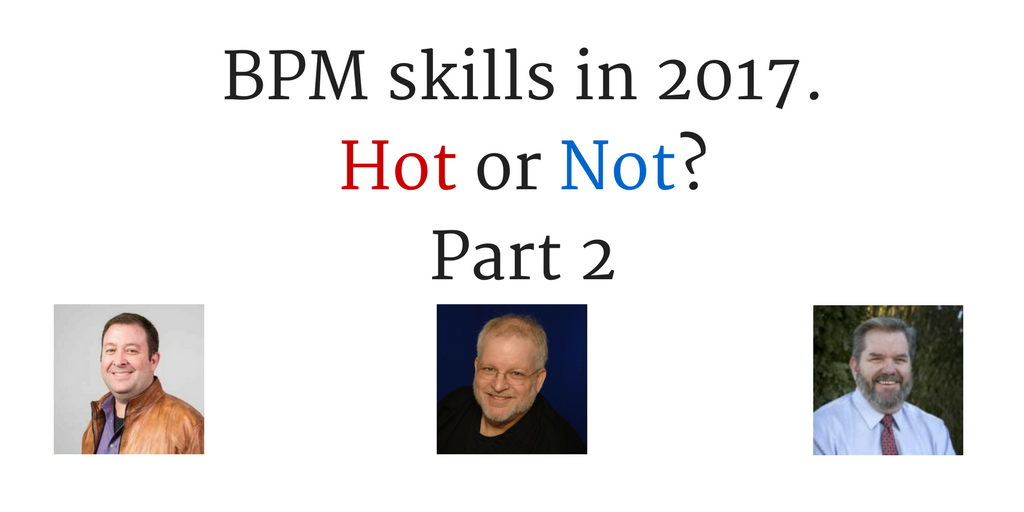I am happy to offer you great addition to BPM skills in 2017 post – tips from 3 BPM thought leaders: Scott Francis, Scott Menter and Roger Tregear.

Scott Francis
 Scott Francis is CEO and Co-Founder of BP3, a BPM specialist firm focused on accelerating process innovation for customers. Scott and his team have grown BP3 into a Leader in Forrester’s Wave for BPM Services Providers, a top 10 Company in Fortune’s Great Places to Work, a top 10 company in Austin’s Fast 50, and to 120 employees worldwide. Scott is a speaker at conferences such as: bpmNEXT, BPMPortugal, and BPMCAMP, and is the primary author of BP3’s blog.
Scott Francis is CEO and Co-Founder of BP3, a BPM specialist firm focused on accelerating process innovation for customers. Scott and his team have grown BP3 into a Leader in Forrester’s Wave for BPM Services Providers, a top 10 Company in Fortune’s Great Places to Work, a top 10 company in Austin’s Fast 50, and to 120 employees worldwide. Scott is a speaker at conferences such as: bpmNEXT, BPMPortugal, and BPMCAMP, and is the primary author of BP3’s blog.
WWW: http://www.bp-3.com
WWW: LI profile
Twitter: @sfrancisatx
What are the skills and techniques that can help BPM practitioners create value for their organizations in 2017?
The skill that never goes out of style or out of date is leadership. Any technology evolution or disruption depends upon people to lead the change, and make sure it is effective. I’ve never seen a BPM program suffer from a surplus of leadership skills.
Leadership will take you through any technology evolution, and into the next one. Mobile. Cloud. Location. Social. IoT. Cognitive. And the next one. Businesses will always rely on leaders to take them in the right direction and to navigate the waters.
Secondly, another “skill” for 2017 to develop is to deeply care about your customers’ businesses. This means understanding your customers’ core motivations, programs, and directives – and values. And it means adapting your work with BPM to align with those objectives and values. And finally, develop a personal regard for their business, make it your business.
E. Scott Menter
 E. Scott Menter is Vice President, Business Solutions for BP Logix, Inc. You can find him on Twitter at @ESMatBPL, or via email at Scott.Menter@bplogix.com.
E. Scott Menter is Vice President, Business Solutions for BP Logix, Inc. You can find him on Twitter at @ESMatBPL, or via email at Scott.Menter@bplogix.com.
WWW: http://www.bplogix.com
WWW: LI profile
Twitter: @ESMatBPL
What are the skills and techniques that can help BPM practitioners create value for their organizations in 2017?
One of the most essential skills for the BPM practitioner—and one that is in incredibly short supply—is simply empathy. In this context, empathy is the ability to put oneself in the mind of one’s customers, and to experience the application and workflow as they do. Enterprises are investing significant resources to build complex digital applications, and then struggling with adoption because, put simply, the user experience is awful. It’s not just a matter of making UIs (forms, reports, and so forth) look pretty: it’s a matter of making them intuitive, timely, and yes, also pretty.
Which skills are no longer relevant or not practically applicable yet (hype)?
The demand for legacy process analysis skills is falling by the wayside. I refer to this phenomenon as “draining the swim lane”; that is, the abandonment of the twentieth century emphasis on flowcharts, “as-is” modeling, and over-analysis. This shift represents a significant mindset change for professionals trained in Six Sigma, OpEx, and yes, even BPMN. But the change is necessary in order to support the broad view of BPM as a platform for digital application development.
Roger Tregear
 Roger Tregear delivers BPM education and consulting assignments, bringing to them 30 years of management consulting experience. He spends his working life talking, thinking, and writing about the analysis, improvement, innovation, and management of business processes. His work has taken him to Australia, New Zealand, Bahrain, Belgium, Nigeria, South Africa, South Korea, Saudi Arabia, The Netherlands, Jordan, United Arab Emirates, and the USA.
Roger Tregear delivers BPM education and consulting assignments, bringing to them 30 years of management consulting experience. He spends his working life talking, thinking, and writing about the analysis, improvement, innovation, and management of business processes. His work has taken him to Australia, New Zealand, Bahrain, Belgium, Nigeria, South Africa, South Korea, Saudi Arabia, The Netherlands, Jordan, United Arab Emirates, and the USA.
Roger is a regular columnist for BPTrends. He is author of Practical Process (2013), co-author of Establishing the Office of Business Process Management (2011), and contributed the chapter Business Process Standardization in The International Handbook on BPM (2010, 2015). With Paul Harmon, Roger edited Questioning BPM? (2016). Roger’s iconic book, Reimagining Management, was also published in 2016. Process Precepts (2017), Roger’s latest book, involves a cosmopolitan, global team in discussions about the process of management.
WWW: http://www.leonardo.com.au
WWW: LI profile
Twitter: @rogertregear
What are the skills and techniques that can help BPM practitioners create value for their organizations in 2017?
Process-based management (BPM as a management philosophy) is a radically different way to think about any organization and how it executes its strategy by delivering value to customer and other stakeholders. Practitioners must properly understand this big picture and then provide the leadership and communicate the ideas. They must be able to clearly describe the value proposition and sell and realize the change. The details of methods, techniques, and technologies are critically important, but the real benefits of process-based management are born of shared ideas about the cross-functional exchange of value, not models and IT systems.
Which skills are no longer relevant or not practically applicable yet (hype)?
Perhaps the more important question is about habits we need to lose. Effective and sustained process-based management is often about linking together much of what has been done to date and giving it a new focus on continually improving organizational performance. To get there we need to break habits like:
- Thinking the M in BPM stands for modeling
- Investing vast amounts in managing up and down the organization chart and very little in managing across the chart where the real action happens
- Confusing BPM with IT
- Thinking process management and improvement is different to innovation, automation, augmentation, transformation, and similar terms
- Thinking BPM is a low level operational issue and not relevant at the executive committee/board table







